Looking to build a bigger, stronger, and more defined upper chest? If so, you’re not alone. The upper chest is one of the most coveted and admired muscle groups, and for good reason.
A well-defined chest is a true symbol of strength and masculinity. However, sculpting the chest is not easy; it requires a targeted approach that focuses more on the upper chest muscles.
This post will explore how to train the upper chest effectively. We will discuss the following topics:
- Anatomy of the upper chest
- Best Upper chest exercises
- Correct form and technique
- Upper chest workout plans.
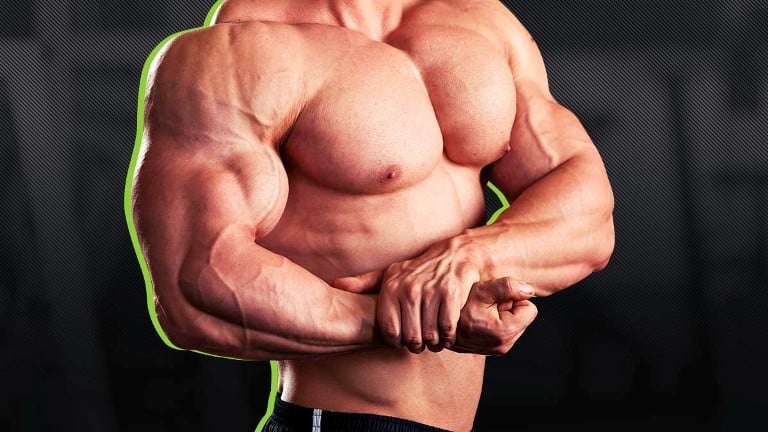
- Upper Chest Muscle (Anatomy)
- How To Train Upper Chest
- 1. Pressing Position
- 2. Body Position
- 3. Grip Position
- 15 Best Exercises To Build The Upper Chest
- 1. Barbell Incline Bench Press
- 2. Incline Dumbbell Press
- 3. Incline Dumbbell Fly
- 4. Incline Cable Fly
- 5. Low To High Cable Fly
- 6. Decline Push-Ups
- 7. Incline Hammer Strength Machine
- 8. The Landmine Chest Press
- 9. Incline Reverse-Grip Bench Press
- 10. Incline Bench Dumbbell Pullover
- 11. Machine Chest Press
- 12. Barbell Overhead Press
- 13. Hindu Push Up
- 14. Dumbbell Incline Around The World
- 15. Smith Machine Incline Press
- Advanced Techniques To Train Upper Chest
- 1. Supersets
- 2. Drop Sets
- 3. Pause Reps
- 4. Eccentric Training
- 5. Rest-Pause Training
- Complete Workout Plans To Train Upper Chest
- Sets And Reps For Upper Chest Workout
- Beginner Upper Chest Workout Plan
- Intermediate Upper Chest Workout
- Advanced Chest Workout
- Frequently Asked Questions About Upper Chest Training
- Do Push-Ups Build Upper Chest?
- Why Is My Upper Chest Not Growing?
- How Do You Work Your Upper Chest Without Weights?
- Conclusion
- Sources
- Best Upper Chest Workout To Build Mass and Strength
Upper Chest Muscle (Anatomy)
To effectively train the upper chest, first we need to take a closer look at the chest anatomy and how to train it.
The chest muscles consist of the pectoralis major and the pectoralis minor.
The pectoralis major is a large, fan-shaped muscle with a wide origin. It is generally divided into two parts:
- The clavicular part is the smaller, upper portion, which originates from the first half of your clavicle. This is what we usually mean by the upper chest.
- The sternocostal part is the larger, lower part of your chest that mainly comes from your sternum (and to a small degree from your upper abdominal sheath and ribs). This is your middle and lower chest.
Muscle fibers from this range come together into one single tendon that inserts into the front of your upper arms.
The pectoralis minor is the triangle-shaped muscle located under the pectoralis major, a layer deeper, and draws the shoulder blades down and forward.
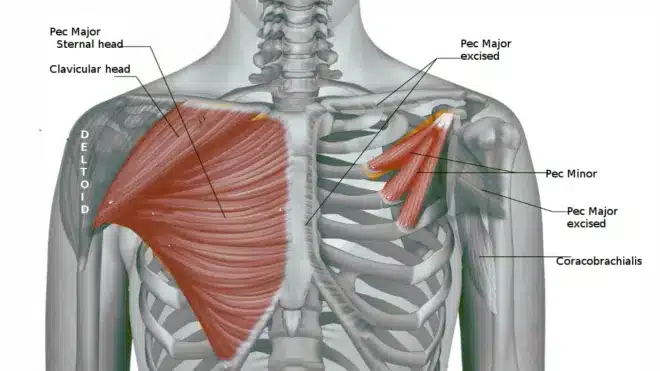
How To Train Upper Chest
If you want to develop the upper chest to get more defined pecs, you need to read this whole blog. Here, I’ll tell you how to make this part of the chest muscle look better.
Here’s the twist: you can’t directly improve only the upper part of the pecs, but you can make it look better quickly if you do the right things.
One of the most important things you can do if you want to build a bigger upper chest is to remember to focus on isolation exercises and strength-building exercises.
Here are some key tips for effective upper chest training.
1. Pressing Position
The pectoral muscles work differently depending on the angle you bring your arm forward.
- The upper chest muscle fibers are the target of Incline pressing.
- The lower chest muscle fibers are the target of decline pressing.
- It is possible to target your complete chest muscle with a flat pressing.
An incline bench press will work the upper chest more than a flat or decline bench press. If you want to increase the stimulation of the upper chest, you should aim for an angle of at least 30 degrees.
The study found that the most activity for the upper part of the pectoralis major muscle occurred when the bench was angled at 30 degrees.
At a zero-degree bench inclination (flat bench), the middle and lower parts of the pectoralis major muscle displayed higher electrical activity.
If you go beyond 30 degrees, you will transfer the emphasis from your upper chest to your front delts.
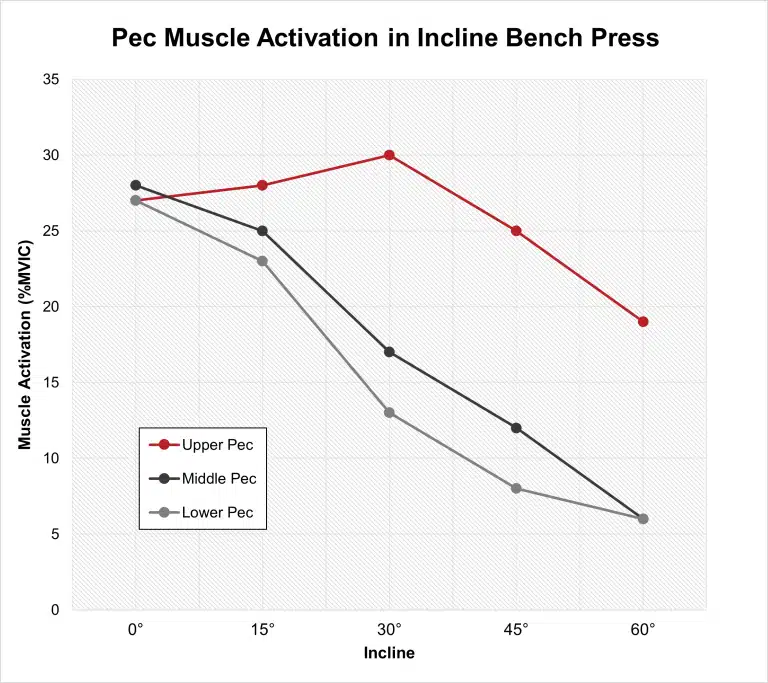
2. Body Position
The decline Push-up works the upper chest and front shoulders (delts) more than the regular or incline push-ups. With a standard push-up, you lift about 70% of your bodyweight.
When you do decline push-ups, you lift more of your body weight by lifting your feet up. This makes the decline variation of push up is more effective and challenging than the standard push-up variation.
3. Grip Position
Changing your grip from overhand to underhand profoundly affects upper chest muscle activation. Changing your grip can increase upper chest activation by up to 30%.
A group of Canadian scientists found that the muscle activity of the upper pecs in weight-trained subjects performing reverse-grip bench presses was more than 30% greater than that in standard-grip bench presses.
The reverse-grip bench press is one of the best exercises you can do to build the upper chest.
15 Best Exercises To Build The Upper Chest
Here is a list of the 15 best upper chest exercises that help to build a well-developed chest. You can also find out how to put together an upper chest workout.
1. Barbell Incline Bench Press
The Incline bench press is a variation of the traditional flat bench press, in which your body is fixed in an incline position.
It focuses more on the upper part of the chest and, therefore, helps build massive upper pecs. It also trains the anterior delt (front shoulder) and tricep muscles.
You could even try the incline Smith machine bench press for more stability. When an exercise is stable, you can use heavier weights, focus more on the muscles worked, and train closer to failure without as much risk of technique breakdowns.
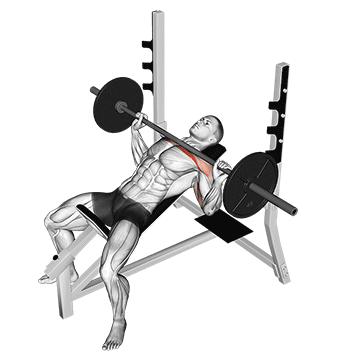
How To Do Incline Bench Press
- Set an adjustable bench to an incline of around 30–45 degrees.
- Lie back on the bench with your feet flat on the floor.
- Grasp the barbell with a grip slightly wider than shoulder-width apart.
- Take the barbell off and lower it towards your upper chest while keeping your elbows at a 45-degree angle.
- Pause briefly, then extend the barbell to the starting position by extending your arms.
- Do 8–10 reps.
Tips
- Perform press in a controlled manner.
- The bar should be lowered slowly until it reaches the upper chest and then paused momentarily.
- Set a bench at about 30–45 degrees inclined. Do not go more upright as the stress shifts to the shoulders rather than the chest area.
2. Incline Dumbbell Press
Incline dumbbell bench press is an excellent exercise to develop the middle and the upper pec muscles. Just like the Incline bench press.
The dumbbell press works mostly on the upper pecs, but dumbbells allow a full range of motion and are, therefore, better than the bench press in some ways. Using dumbbells ensures that you are working equally hard on both sides.
It adds an extra range of motion at the top for complete chest development. Furthermore, dumbbells demand better coordination, forcing the stabilizing muscles to assist as well.
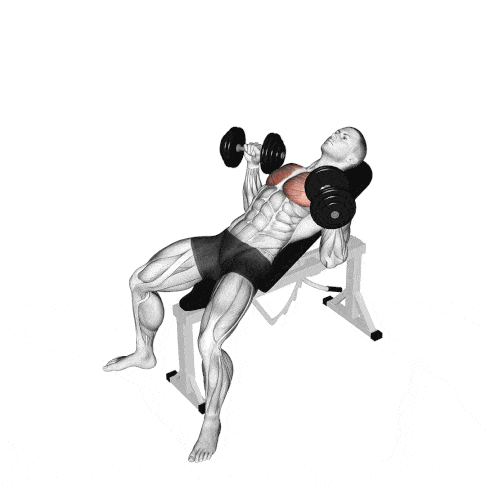
How To Do Incline Dumbbell Press
- Grab a pair of dumbbells, and lie on an incline bench (30 degrees inclined).
- Clean the dumbbells and lift them straight overhead. Feel a good chest squeeze at the upper pec.
- Lower the dumbbells and feel a good chest muscle stretch at the bottom.
Tips
- Keep a controlled motion and avoid jerky movements.
- Always use weights that you can handle comfortably.
- Keep the tension on your chest as you press the weight up.
- Vary bench angles to hit different angles of the chest.
Read More: How To Do Incline Dumbbell Bench Press With Perfect Technique
3. Incline Dumbbell Fly
The incline dumbbell fly is a variation of the dumbbell fly specifically targeting the upper chest muscle.
Incline dumbbell chest fly, a bodybuilding favorite, is an isolation exercise usually performed after big compound lifts like the bench and incline press.
After many pressing exercises, it is considered the perfect finishing move and a great way to focus on your chest.
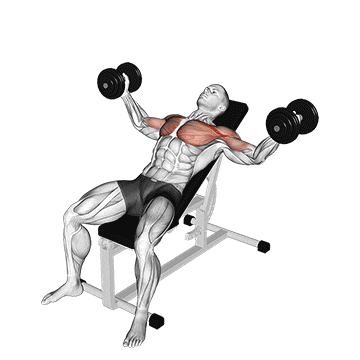
How To Do Incline Dumbbell Fly
- Set an incline bench at a 30-to-45-degree angle.
- Lie on the bench with your feet flat on the floor.
- Lift your arms straight up from your shoulders and the dumbbells directly over your upper chest.
- Slowly lower your arms to your sides until your wrists reach about shoulder level or slightly above.
- Bring your arms back to the middle of your body and use your pec muscles to bring them together.
Tips
- Pick a weight that you can control, that’s not too light or too heavy — find what’s right for you.
- Maintain tension in your abs and don’t allow your lower back to excessively arch.
- Don’t let the dumbbells touch as they meet at the top, holding for a second in the contracted position.
4. Incline Cable Fly
Incline Cable fly is one of the most suitable exercises for isolating the upper chest muscles.
Unlike dumbbell or barbell exercises, the cable machine provides constant tension throughout the entire range of motion, resulting in continuous muscle engagement and a more effective chest workout.
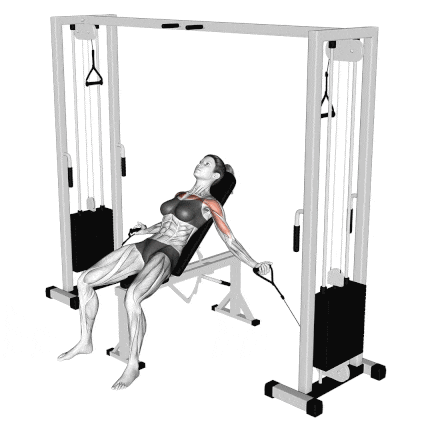
How To Do Incline Cable Fly
- Set the bench at an incline angle of around 30-45 degrees.
- Attach the stirrup handles to the low pulleys and lie on the bench.
- Hold the cable handles with your arms extended out in front of you, using an overhand grip.
- Slowly lower the cable attachments outward to your sides.
- Keep your upper arms parallel to the floor and your elbows slightly bent throughout the movement.
- Bring your arms back toward the midline of your body.
Tips
- Focus on the mind-muscle connection.
- Keep your elbows slightly bent to minimize joint strain and maximize tension on the chest muscles.
- Hold and contract the chest muscles when hands are together.
5. Low To High Cable Fly
The low-to-high cable fly is a unique chest exercise that isolates the pectoral muscles through a full range of motion. This cable fly variation is a good way to build strength and size in the pecs when you want to work on the upper chest area.
You can work your muscles hard without worrying about lifting heavy weights, such as a barbell or dumbbells, over your head.
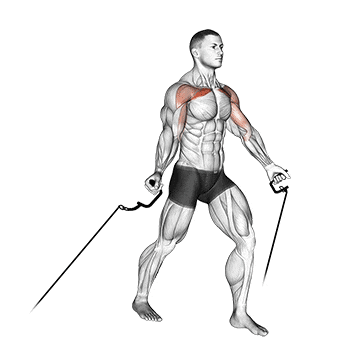
How To Do Low Pulley Cable Crossover
- Set the pulleys on a cable machine to a low position and attach the handles.
- Stand in the center of the cable machine.
- Grasp the handles, one in each hand, with your palms facing forward.
- Take a step forward to create tension on the cables, and position your arms slightly in front of your body.
- With a slight bend in your elbows, exhale and pull the handles forward and across your body in an arc motion until your hands meet in front of your chest.
- Pause momentarily, squeeze your chest muscles, and then inhale as you slowly return to the starting position, allowing your arms to stretch back out.
Tip
- To keep your balance, stand in a staggered stance.
- Breathe out as you lift the handles up and together.
- Control the weight as you bring your arms back down.
Know More: 14 Best Cable Chest Exercises And Workout Routine
6. Decline Push-Ups
Push-ups are one of the best bodyweight exercises for training the upper body, including the shoulders, chest, and triceps.
Decline Push-ups are similar to normal push-ups but with your legs on a bench. Although this is called the Decline push-up, it focuses more on the upper pecs.
Furthermore, because your lower body is raised from the floor, your body’s resistance is increased compared to doing the push-up on the floor. This makes the decline push-up harder than the standard push-up.
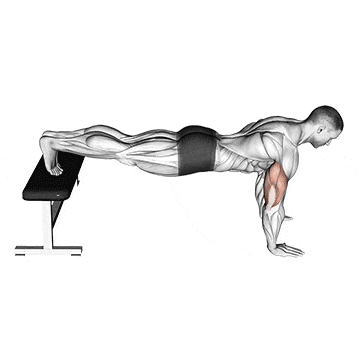
How To Do Decline Push-Ups
- Your hands are placed firmly on the floor and spaced slightly wider than shoulder-width apart.
- Put legs on the bench or the pad roller.
- Now, lift yourself off the ground, straightening your elbows and arms. Keep your elbows close to your body.
- Raise until your elbows are almost near to locked, and pause for a moment at the top of the movement.
- Now lower your body under slow, sustained motion, feeling the motion all the way down until your chest is very close to the ground.
Tips
- Do not let your lower back sag or your butt rise. Ensure your body is straight and rigid.
- Slow down all of your movements and really stay focused on your form.
- The core and glutes should be contracted during the exercise.
Read More: Best Push Ups For Upper Chest
7. Incline Hammer Strength Machine
The machine provides a stable platform and reduces the need for stabilizer muscles. It isolates the upper chest and lets you focus on working the muscles.
Furthermore, it reduces the likelihood of form breakdown. If you fail a repetition, you can lower the machine back down without any chance of injuring yourself.
The machine’s design and the way it moves help keep joints less stressed.
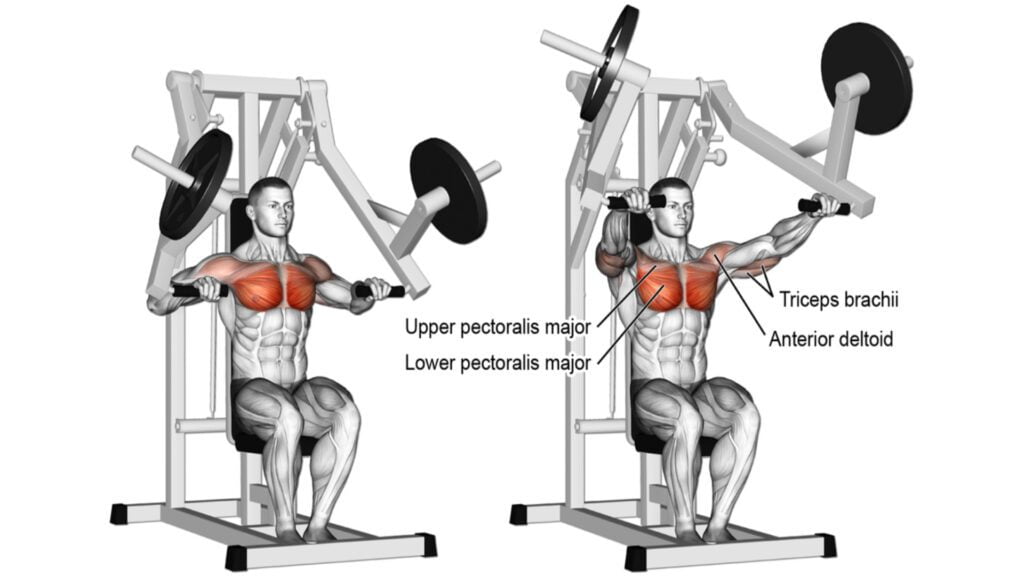
How To Do Incline Hammer Strength Machine
- Adjust the seat height and backrest of the Hammer Strength machine to align your chest with the handles.
- Grasp handles and sits up straight with core tight and back pressed against the seat.
- Exhale and push the handles forward while extending your arms, bringing them together in front of your chest.
- Pause briefly at the movement’s peak, squeezing your upper chest muscles.
- Inhale and slowly reverse the motion, letting the handles return to the starting position.
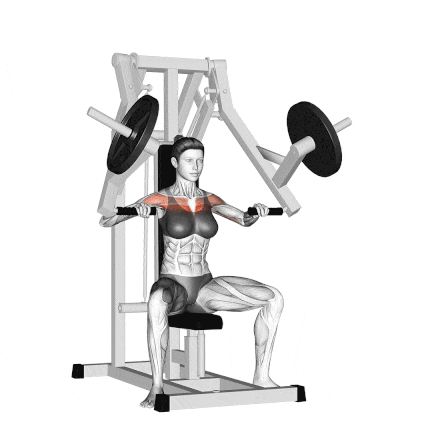
Tips
- Maintain a slight bend in your elbows to keep tension on the chest muscles and avoid locking out the joints.
- Change grip positioning to target different parts of the muscles.
- Experiment with different grip positions, such as neutral, to target slightly different upper chest areas.
8. The Landmine Chest Press
The landmine chest press is not a popular exercise, but it provides many benefits when it comes to building bigger upper chests.
The landmine attachment can rotate freely, so pressing movements are easy. This helps to reduce stress on the shoulders and wrists.
It can be performed in a kneeling position, which increases core involvement and can improve core stability and abdominal muscle strength.
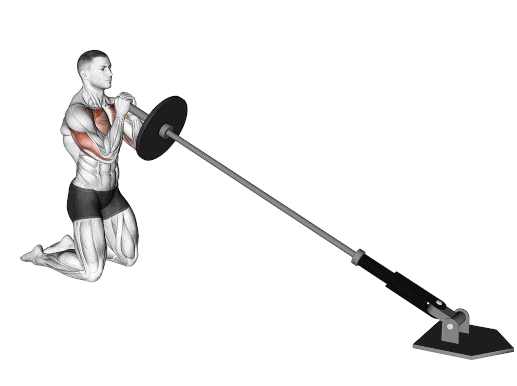
How To Do Landmine Press
- Place a barbell in a landmine holder or set up a barbell in a corner.
- Then add weight plates to the free end of the barbell.
- Assume a half kneeling position with the knee under your hip, toes tucked, and rib cage down.
- Press the barbell up straight in front of you until your arms are extended, avoiding hyperextension at the elbows.
- Hold the weight for a second and focus on contracting your chest muscles.
- Slowly lower the weight back towards your chest and then repeat for the recommended reps.
Tips
- To secure the barbell, you can interlock your hands around the bar.
- Lean your body forward slightly and engage your core muscles to help with stabilization.
- Exhale on pushing movement, and inhale when returning to the starting position.
Know More: Landmine Exercises For Building Muscle And Strength
9. Incline Reverse-Grip Bench Press
When you bench press, changing your grip from overhand to underhand can make your upper chest muscles work 30% more.
An Incline bench barbell press with a reverse grip actually shifts the most focus to the upper pecs. The reverse grip activates the front delts and triceps to a greater extent, providing a well-rounded upper body workout.
Start out light and ensure your thumbs are hooked around the bar for safety.
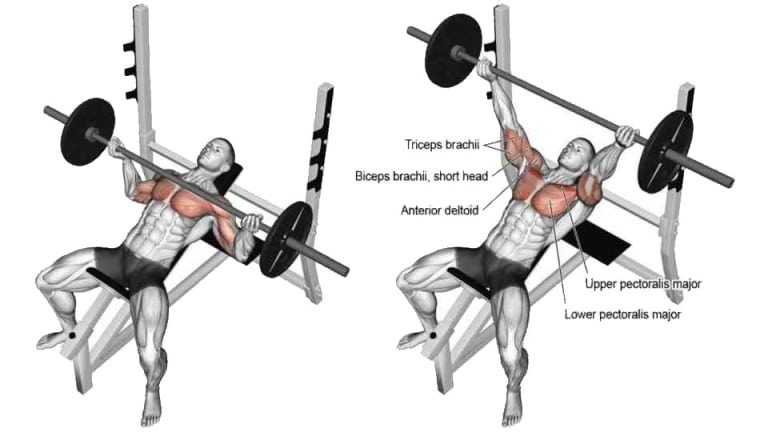
How To Do Incline Reverse-Grip Bench Press
- Lying on a flat bench, grasp the bar with a supinated (reverse) grip, shoulder-width apart, and thumbs around the bar.
- With your elbows tucked in close to your sides, slowly lower the bar down to your lower pecs.
- Press the bar back up to the start position in a slight backward arc without letting your elbows flare out.
- Don’t lock out your elbows at the top of the rep; keep a bend in your arms, maintaining control of the weight at all times.
Tips
- Hold a neutral spine throughout the movement to prevent injury.
- Perform press in a controlled manner.
- Exhale on pushing movement, and inhale when returning to the starting position.
- Contract the chest muscles at the top of the movement.
10. Incline Bench Dumbbell Pullover
Incline bench dumbbell pullovers are the best exercise to build a strong rib cage and build the serratus anterior muscle.
This exercise works on the chest muscles, especially the upper part of the chest. It also works on the muscles in the back called the latissimus dorsi.
The pullover motion can stretch the rib cage, allowing for improved breathing mechanics and chest expansion.
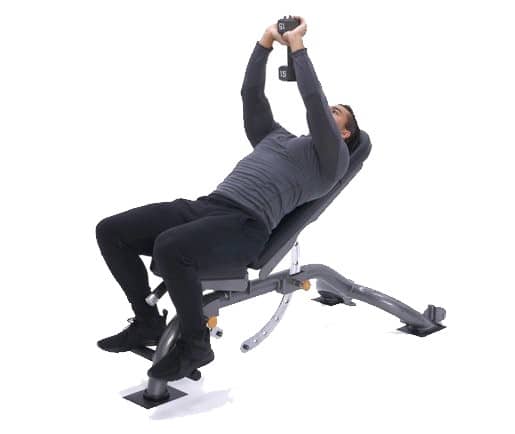
How To Do Incline Bench Dumbbell Pullover
- Set an incline bench to an angle between 30 to 45 degrees.
- Hold a dumbbell with both hands, palms facing up, and Carefully lie back on the bench.
- Extend your arms over your chest, keeping a slight bend in your elbows.
- Inhale deeply and lower the dumbbell backward in an arc motion towards the floor.
- Once you feel a stretch in your chest and upper back, exhale and bring the dumbbell back to the starting position.
Tips
- Maximum stretching ensures the greatest expansion of the rib cage.
- Vary the position of the bench to hit different angles of the upper chest.
Related: Upper Chest Dumbbell Exercises For Building A Broad, Strong Pecs
11. Machine Chest Press
Machine chest press is a resistance exercise that involves pushing a weight away from the body using a machine with a chest press attachment.
According to EMG research, the machine bench press involves the shoulders to a lesser extent than free-weight alternatives. This means you can focus more on working your chest muscles.
The machine allows you to isolate and target the chest muscles while providing support and stability. There are several types of chest press machines available, including plate-loaded and cable machines.
Variations Of Machine Press For Building Upper Chest Muscles
- Close grip machine chest press
- Reverse grip chest press
- Incline machine press
- Lying machine chest press
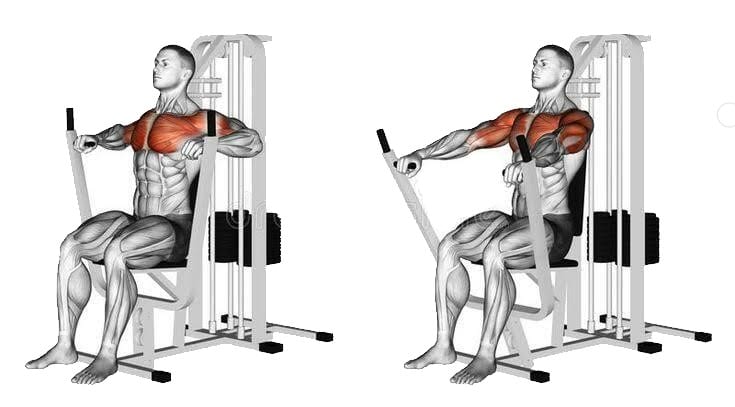
How To Do
- Adjust the seat of the machine so that the handles are at chest level.
- Sit on the machine with your back flat against the backrest and your feet flat on the floor.
- Grasp the handles with an overhand grip and press them away from your body until your arms are fully extended.
- Slowly bring the handles back towards your chest, keeping your elbows tucked in and your wrists straight.
Tips
- Keep your shoulders back and down to prevent them from hunching forward.
- Exhale as you push the handles away from your body, and inhale as you bring them back towards your chest.
- Start with a light weight and gradually increase the resistance as you get stronger.
12. Barbell Overhead Press
The overhead press is the best exercise for building shoulder and upper chest muscle mass and strength. It remains the grand-daddy of all shoulder exercises to build big, round shoulder muscles.
Performing the exercise while seated upright is a stricter version than standing and prevents cheating the weight upward using momentum generated by the legs.
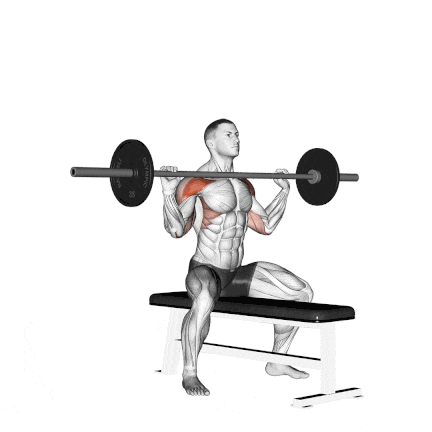
How To Do Barbell Overhead Press
- Sit on an exercise bench and grab a bar with an overhand grip.
- Bring the bar over and in front of your head, under your chin, and just above your upper chest.
- Now Press the bar straight up overhead until your arms are fully extended but not locked out.
- Slowly lower the bar back to the starting position.
Tips
- Perform a warm-up with 50% weight for 1-2 sets.
- Always perform the Shoulder Exercises before you perform the triceps.
13. Hindu Push Up
The Hindu push up is a traditional Indian-style exercise practiced by wrestlers. It also provides better strength and endurance to the muscles.
The Hindu push-up is a complete exercise that has a compound effect. It improves flexibility and posture.
It works from your whole body, from upper to lower body; it works from your chest to back.
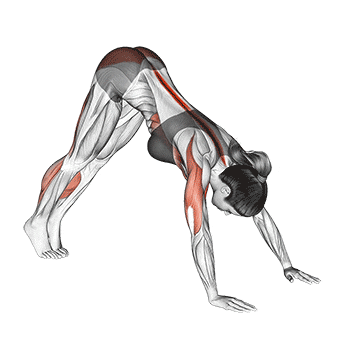
How To Do Hindu Push Up
- Start in a downward dog pose, your body in a V shape.
- Bend your elbows and lower your chest until it’s just above the floor, going into a low plank pose.
- In a scooping motion, lift your head upward while arching your lower and upper back, then go into cobra pose.
- You do not need to reverse back through the sweeping, arching motion to return to the starting position.
- Engage your core, relax the spine and neck, open the shoulders, and keep the movement smooth.
14. Dumbbell Incline Around The World
Dumbbell Incline Around the World is another great exercise for your upper chest dumbbell workout.
To do this exercise, you can still use an incline bench, but you’ll need to adjust the bench so that get the good contraction.
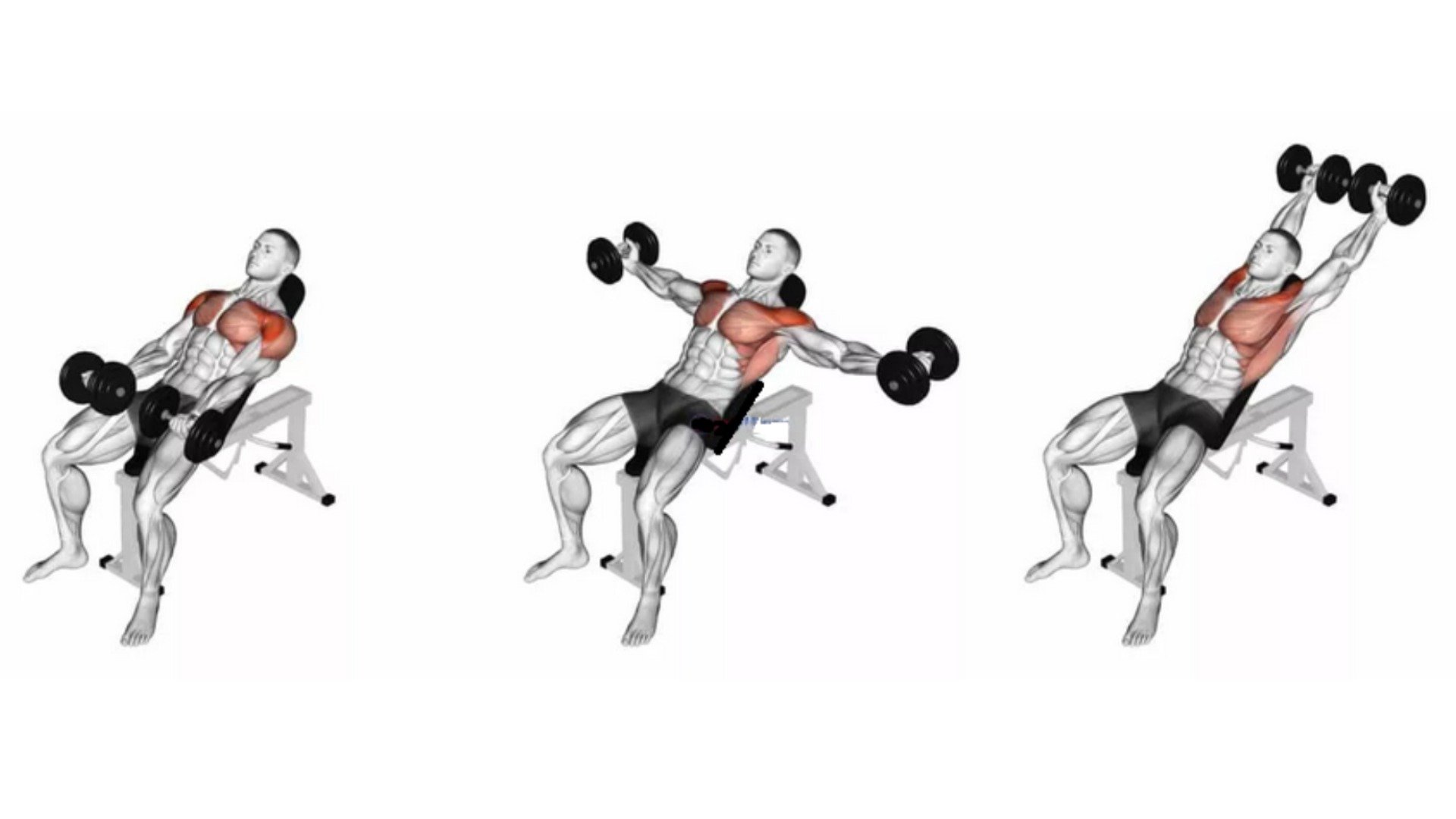
How To Do Dumbbell Incline Around The World
- Lie on an incline bench holding a dumbbell in each hand next to your thighs with palms facing up.
- Take the dumbbells and create a semicircle by rotating them up over your head with the motion staying parallel.
- All the movement should always happen with the arms parallel to the bench. Breathe in as you perform this portion of the movement.
- Reverse the movement to return the weight to the starting position as you exhale. Repeat this exercise for as many repetitions as needed.
Tips
- Perform press in a controlled manner.
- Make sure to utilize a full range of motion throughout the exercise.
15. Smith Machine Incline Press
The Smith machine is popular among bodybuilders and powerlifters who want to make their incline press more powerful. It lets you lift heavier weights without balancing or stabilizing the bar. This helps you get stronger and make your chest muscles bigger.
The presence of safety catches on the Smith machine allows for independent lifting without the need for a spotter.
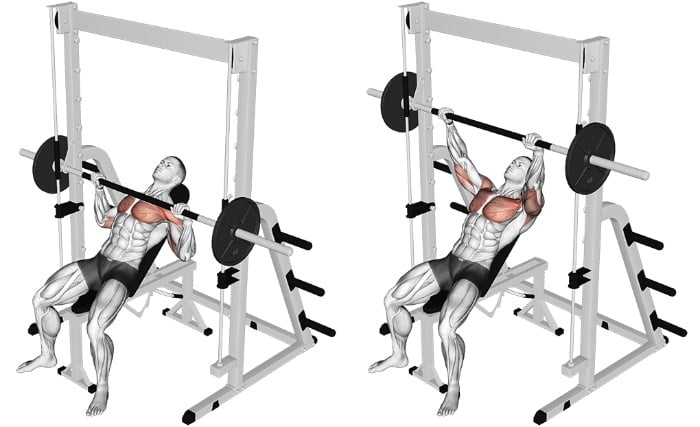
How to Do Smith Machine Incline Press
- Adjust the bench to an inclined position.
- Position yourself on the bench with your feet flat on the floor for stability.
- Grasp the barbell with an overhand grip slightly wider than shoulder-width apart.
- Unrack the barbell by lifting it off the safety catches and hold it directly above your chest.
- Lower the barbell slowly and under control until it touches your upper chest.
- Push the barbell back up along the same path until your arms are fully extended, but avoid locking out your elbows.
Tips
- Avoid excessive arching of the lower back.
- Always prioritize proper form over heavy lifting.
- Keep your shoulders retracted and your back firmly pressed against the bench.
Advanced Techniques To Train Upper Chest
When it comes to training the upper chest, advanced techniques can help to grow more muscle and improve overall development.
Here are some advanced ways to work on your upper chest:
1. Supersets
Combine two exercises that work on the upper part of your chest in a superset way.
For instance, perform a set of incline dumbbell presses immediately followed by a set of incline cable flies, without any rest in between.
Supersets increase training intensity, promote muscle fatigue, and enhance the overall effectiveness of your workout.
2. Drop Sets
Start with a heavier weight and perform an exercise until failure. Then, immediately reduce the weight and continue the set without rest.
Drop sets help increase muscle fatigue and recruit additional muscle fibers for greater stimulation.
3. Pause Reps
During your sets, incorporate pauses at different points of the exercise to increase time under tension and challenge the muscles further.
For example, perform an incline bench press and pause for 2-3 seconds at the movement’s bottom, mid-range, or top. This technique stimulates greater muscle recruitment and promotes muscle growth.
4. Eccentric Training
Research has shown that eccentric training increases muscle growth and strength more than traditional training methods.
Eccentric training focuses on emphasizing the lowering (eccentric) phase of the exercise, which has been found to stimulate muscle hypertrophy.
To incorporate this technique, perform the eccentric phase of the exercise (e.g., lowering the weight during an incline bench press) slowly and under control.
5. Rest-Pause Training
According to research, rest-pause training results in a greater level of muscle activation and metabolic stress than traditional sets.
Rest-pause training involves performing a set to failure, briefly resting (10-20 seconds), and then continuing with additional reps using the same weight.
This technique helps to recruit more muscle fibers and increase training volume.
Complete Workout Plans To Train Upper Chest
If you want to balance your chest workout, add 1-2 of the following upper chest exercises. We recommend that you train your entire chest during your chest workouts because your upper chest muscles are a small part of your whole chest.
If your Upper Chest is considerably undeveloped, I suggest choosing 2 of these exercises and performing 1 of them at the start of your Chest workout. If your Upper Chest is well-developed, but you’re looking to continue to add mass, then I would suggest choosing only 1 exercise.
Before you start a chest workout, make sure you warm up properly. Then, do a few warm-up sets with lighter weights or just your body weight before doing the exercises with heavier weights.
Sets And Reps For Upper Chest Workout
Of course, the number of sets and reps will be determined based on your fitness journey, but here is a great starting point:
Sets
- Beginners: ~10 sets per week.
- Intermediate: ~15 sets per week.
- Advanced: ~20 sets per week.
When a certain amount of volume stops being effective and your progress stalls, you can add sets to increase volume and use that as a driver of renewed progress.
Reps
The best rep ranges and loads to work with.
- 6-8 reps with a heavy load
- 8-15 reps with moderate load
- 15-20+ with a light load
For the exercise to be effective, the load should bring you to or near failure within the given rep ranges.
Find the workout that suits your experience level and goals.
Challenge Yourself
Don’t be afraid to challenge yourself if you want to see actual results. This could mean doing supersets or drop sets, which are great ways to work towards failure. Rest when needed between sets, but keep going if you can complete a superset.
Beginner Upper Chest Workout Plan
If you’re new to lifting weights, don’t worry. This beginner-friendly chest workout routine is a great place to start.
When this gets easy, choose a heavier free weight. After you’ve upped your weight several times and feel strong in the movements below, move on to the intermediate routine. Until then, you can follow this beginner chest workout plan.
| Exercise | Sets | Reps | Rest |
|---|---|---|---|
| Decline Push-Ups | 4 | 8-12 | 60-90 sec |
| Incline Dumbbell Press | 4 | 8-10 | 60-90 sec |
| Incline Dumbbell Fly | 3 | 8-10 | 60-90 sec |
Intermediate Upper Chest Workout
If you are an intermediate level or have outgrown the beginner routine, try the intermediate chest workout routine below.
Regardless of how many reps your programming is calling for, you should be unable to complete the last one with proper form.
| Exercise | Sets | Reps | Rest |
|---|---|---|---|
| Dumbbell Bench Press | 4 | 8-10 | 60-90 sec |
| Incline Barbell Press | 4 | 8-12 | 60-90 sec |
| Low Pulley Crossover | 3 | 8-10 | 60 sec |
| Dumbbell fly | 3 | 12-15 | 60 sec |
Advanced Chest Workout
If you are an advanced-level athlete or have already completed the beginner and intermediate chest workouts, try the advanced routine.
Here, you’ll challenge more of your balance, stability, and strength.
| Exercise | Sets | Reps | Rest |
|---|---|---|---|
| Incline Barbell Bench Press | 4 | 8-10 | 60-90 sec |
| Landmine Press | 4 | 8-12 | 60 sec |
| Incline Cable Fly | 3-4 | 8-10 | 45-60 sec |
| Dumbbell fly | 3 | 12-15 | 45-60 sec |
| Decline Push-Ups | 3 | 15-20 | 60 sec |
Frequently Asked Questions About Upper Chest Training
Do Push-Ups Build Upper Chest?
Decline Push-ups are an excellent bodyweight exercise for strengthening the upper chest, but decline push-ups on a stability ball take this routine to the next level.
Why Is My Upper Chest Not Growing?
It might be that you aren’t doing enough exercises that work the upper chest.
A good upper chest workout routine should use bench angles between 30 and 45 degrees and use both good rep range training. Pecs respond to these types of workouts.
How Do You Work Your Upper Chest Without Weights?
The decline and pike push-ups are two of the best exercises for working the upper chest without weights. By placing your feet on an elevation (like a low bench or box) and performing decline push-ups, you can target your middle and upper chest instead.
Conclusion
If you want to work your upper chest, you can target it with exercises like the incline bench press or work it all with exercises like the bench press.
This exercise is highly recommended for anyone interested in building upper body strength and gaining muscle size. It is easy to do and does not require more scientific details or fancy equipment.
If you do these upper chest exercises consistently, the results will speak for themselves.
Sources
- Int J Environ Res Public Health. 2020 Oct 8;17(19):7339. Effect of Five Bench Inclinations on the Electromyographic Activity of the Pectoralis Major, Anterior Deltoid, and Triceps Brachii during the Bench Press Exercise.
- Comparative Study Eur J Sport Sci. 2016;16(3):309-16. Epub 2015 Mar 23. Influence of bench angle on upper extremity muscular activation during bench press exercise.
- Int J Exerc Sci. 2020 Aug 1;13(6):859-872. Effects of Horizontal and Incline Bench Press on Neuromuscular Adaptations in Untrained Young Men.
- Glass SC, Armstrong T. Electromyographical activity of the pectoralis muscle during incline and decline bench presses. J Strength Cond Res. 1997;11(3):163–167.
- Ebben, William P; Wurm, Bradley; VanderZanden, Tyler L; Spadavecchia, Mark L; Durocher, John J; Bickham, Curtis T; Petushek, Erich J. Kinetic Analysis of Several Variations of Push-Ups. Journal of Strength and Conditioning Research 25(10):p 2891-2894, October 2011. | DOI: 10.1519/JSC.0b013e31820c8587
- Barnett, Chris, Kippers, Vaughan, and Turner, Peter (1995). Effects of variations of the bench press exercise on the EMG activity of five shoulder muscles. Journal of Strength and Conditioning Research 9 (4) 222-227.
Best Upper Chest Workout To Build Mass and Strength

Manish is a NASM-certified fitness and nutrition coach with over 10 years of experience in weight lifting and fat loss fitness coaching. He specializes in gym-based training and has a lot of knowledge about exercise, lifting technique, biomechanics, and more.
Through “Fit Life Regime,” he generously shares the insights he’s gained over a decade in the field. His goal is to equip others with the knowledge to start their own fitness journey.
